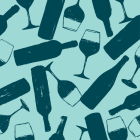Dom Perignon partners with Bulgari for limited edition champagne
Champagne house Dom Perignon is teaming up with Italian jewellery brand Bulgari to create a limited edition 2004 rose Champagne.
The “Bulgari Serpenti x Dom Perignon Rosé” collaboration is limited to just four cases worldwide, and includes a bespoke rose gold Bulgari Serpenti necklace – set with white diamonds and onyx –draped around the neck of each magnum. Each bottle is engraved with a snake scale design.
Compared to the problematic 2003 vintage, vines from the 2004 harvest saw smooth and steady growth leading to abundant, sizeable grape clusters. An uneventful growing season, followed by a few final weeks of dry heat, subsequently resulted in the full-bodied wine which was then aged in the cellar for 12 years.
The limited edition offering is priced at €230,000 and will be released shortly in London, Milan, Paris and Tokyo.
Napa Valley Library Wine Auction raises $933,000
The inaugural Napa Valley Library Wine Auction took place from 11-20 February and raised $933,000, with more than 500 bidders across 41 US states taking part.
Top lots included: a 15-magnum vertical of Shafer, which sold for $42,000; three magnums of Screaming Eagle 2015, which sold for $40,000; and a 10-magnum vertical of Bryant Estate, which went for $40,000.
Other highlights included five six-litre bottles of Opus one – including the 1979 vintage – which sold for $40,000, and five magnums of 100-point-scoring Harlan Estate vintages, which sold for $24,000.
“This auction showcased the calibre of age-worthy wines Napa Valley is known for, and demonstrated that collectors around the world believe in the investment value of the Napa Valley name,” said Jeff Zacharia, president of Zachys, which ran the auction.
Proceeds from the auction will go directly towards Napa Valley Vintners’ programmes to promote and protect the region.
Linda Reiff, president of Napa Valley Vintners, said the organisation was “overjoyed” to have exceeded its fundraising goal. “Our rich history of winemaking excellence was on display for the world to see and we couldn’t be more thrilled with the results,” she said.
Austria applauds ‘challenging yet rewarding’ 2020 vintage
Austria’s 2020 vintage was accompanied by a host of challenges but has ultimately emerged successful, according to the Austrian Wine Marketing Board (AWMB).
In its vintage report, the AWMB said 2020 was characterised by a succession of opposite weather patterns. The growing season started out warm and dry, but then saw fluctuating periods of heavy rainfall followed by a “good old-fashioned summer”. Some areas – Wachau, Kremstal and Traisental, for example – then saw “serious damage” from localised hailstorms, while September bought a mix of sunshine and rain across the country.
Nonetheless, expectations are high for the country’s reds and whites, with whites from the Leithaberg DAC and reds made from Zweigelt and Blaufrankisch showing particular promise, according to the report.
Niederosterreich and Wien produced “very fresh and fruity wines” with a slightly lower alcohol content and more acidity than in recent years. The reds are also somewhat lighter in body.
The wines produced in Steiermark, meanwhile, are expected to show strong “regional typicity” this year, with the region’s flagship Sauvignon Blanc proving “especially attractive and characteristic”.
Argentinian winery celebrates ‘stunning’ results from underwater ageing
Argentinian winery Wapisa says the results of its nine-month underwater ageing experiment are “stunning”, and that it plans to submerge a second lot of bottles later this month.
The winery is the first in the country to experiment with underwater ageing. As part of its new ‘coastal terroir’ initiative, the Rio Negro-based producer submerged 1,500 magnums of its 2017 Malbec-blend in crates at depths between six and 15 metres, 25 kilometres away from their vineyards, off the shore of Las Grutas. The wines remained in place for nine months before being tasted alongside those aged on land.
Wapisa owner Patricia Ortiz explained that the team was curious to see if underwater ageing could help create young wines “with the benefit of maturity”.
“We tasted the underwater-aged wine and the cellar-aged counterparts blind, the difference was stunning: the former was rounder, more elegant and with fresher fruit,” she said.
The second stage of the experiment will see more bottles submerged this month, this time in improved cages that will allow sea water to circulate through the bottles. The results will then be made available for consumers to try themselves.






